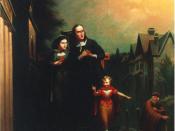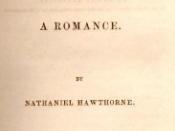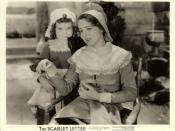SYMBOL1.Scarlet Letter "A"A = Adultery (sin)The meaning changes through the times. Adultery---Able~ Able to face the society with dignity~ Able to accept her punishment alone without any support and friends~ Able to be a mother for Pearl2.Rosebush (Chapter 1: The Prison Door, p. 40-41)Hester = rebel, young soul, conservative, endured.
3.Prison Door (Chapter 1: The Prison Door, p. 40-41)Puritan Community = strict, old generation, conventional.
4.Scaffold (Chapter 2)Moral Discipline = Puritan stiffness rules5.Small Cottage (Chapter 5: Hester at Her Needle, p. 68 )Alienated = living far from the communityCovered by plants that not hiding all of the cottage6.Pearl (Chapter 7: The Governor's Hall, p. 86)A living version of "A"Hester spiritSincerity and Purity7.Black ManRefer to witch communion on the forest surround Puritan Community8. Darkness and LightDarkness: Full of secretWhen Hester and Dimmesdale meet in the forestOn the scaffold at midnightIn Dimmesdale's room, etcLight: Exposed to public knowledgeOn the scaffold when Hester being publicly humiliatedWhen Dimmesdale confess her secret or sin9.
ForestSanctuary = Free world10. Meteor's light (Chapter 12: The Minister's Vigil, 130-134)To Dimmesdale = Adultery, He should wears the same mark as Hester does (mark of shame)To the rest of the community = Angel, marks Governor Winthon's entry into heaven11. Flood of Sunshine (Chapter 18)Dimmesdale's feeling that full of happiness and hope expression after get Hester's advice12. Black GloveVeil of something hidden (Chapter 12: The Minister Vigil)13. Brook (Chapter 19: The Child at the Brookside, p. 178-179)The limit that Pearl doesn't want to cross over14. Dimmesdale's mark on his bosom (Chapter 23: The Revelation of The Scarlet Letter)His hidden sin of adultery and his hypocrisySYMBOLIC ACTS1.Hester living along with the community instead of leaving the citySymbolize her toughness2.Pearl seems happy when she avoid the children of the Puritans want to threat Hester (Chapter 7: The Governor's Hall, p 86)Act of protection3. Dimmesdale is covering his bosom with his handHiding his sins not to let other people know4. Dimmesdale turns to perform his evil side, e.g. deceive not recognize his loyal church members (Chapter 20: The Minister in a Maze)Hidden selfish5.Dimmesdale's kiss on Pearl (Chapter 19: The Child at The Brookside)Symbolize his confession of his sin with Hester and of Pearl as his child6.Pearl's washing her forehead from Dimmesdale's kiss (Chapter 19: The Child at The Brookside)Symbolize her reluctance to accept Dimmesdale's acknowledgement of her since he does it secretly, not in front of the society, and she doesn't like it that Dimmesdale keeps on hiding his bond with her and Hester7.Pearl's kiss on Dimmesdale (Chapter 23: The Revelation of The Scarlet Letter)Show her acceptance and acknowledgement toward Dimmesdale as her fatherIRONYA.Irony of Situation1.About DimmesdaleHe supposed to be good as Reverend, but in fact, he done one of the sinful deeds, which is Hester's fellow-sinner.
2.About the Scarlet LetterIt supposed to be a symbol of sin, but Hester makes the embroidery with high complexity so that the scarlet letter looks beautiful.
The scarlet letter undergoes a shift of meaning. At first, it stands for "adulteress", which has negative meaning. Then, later on, it stands for "able" since Hester help others with her ability.
3.About Hester's clothesPeople expect to see Hester, when she's about to go to scaffold, dimmed and obscured by a disastrous cloud upon her. But, in fact Hester shines beautifully.
She makes embroidery but she herself wears simple unsophisticated clothes.
4.Hester married to Chillingworth, but none of the two of them love each other. (Chapter 4: The Interview, p. 63)5.About Pearl (Chapter 6: Pearl, p. 75)Pearl is the sign of sin, but Hester named her Pearl instead as she is her valuable treasure.
6.After hearing Dimmesdale's confession, people respect him more instead of consider him as the worst-sinner and hypocrite. (Chapter 11: The Interior of Heart, p. 122-123)7.Dimmesdale and Chillingworth are suffered more than Hester.
8.Hester insists staying in that Puritan settlement instead of leaving.
B.Dramatic Irony1.Dimmesdale lives in the same house as Roger Chillingworth (Chapter 9: The Leech, p. 107)2.About Sexton's line (Chapter 12: The Minister Vigil, p. 134)"A pure hand needs no glove to cover it."3.Dimmesdale shares his feeling of agony to Chillingworth without knowing that Chillingworth is the one who wants to array him. (Chapter 10: The Leech and His Patient, p. 110-112)4.Hester and Pearl is standing near the Scaffold, looked by the cruelty crowd of people; meanwhile, Dimmesdale is standing on the platform is admired and praised by the church members (Chapter 22: The Procession)Hester realizes there's something wrong with Dimmesdale indicated by his gesture and eyes-look, Hester think he might be wants to reveals his sin on his speechC.Verbal Irony1. Dimmesdale says to Hester: (Chapter 3: The Recognition, p. 57)"I charge thee to speak out the name of thy fellow-sinner and fellow-sufferer!"2. Chillingworth says to Dimmesdale: (Chapter 10: The Leech, p. 116)"â¦We shall be friends again anon.""Let me ask-as our friend, as one having chargeâ¦-hath all the operation of his disorder been fairly laid open and recounted to me?"BibliographyARP, Thomas R. Perrine's story and structur, 9th edition. Orlando: Harcourt Brace College Publishers. 1998Hawthorne, Nathaniel. The Scarlet Letter. New York: Penguin Books. 1987







